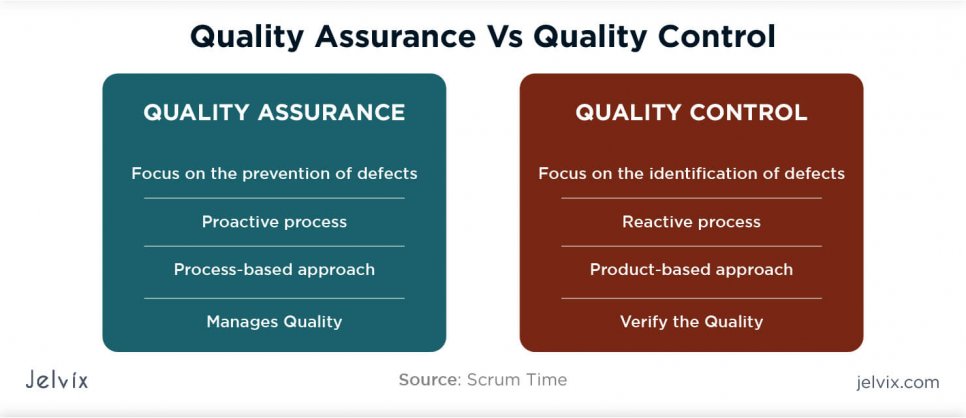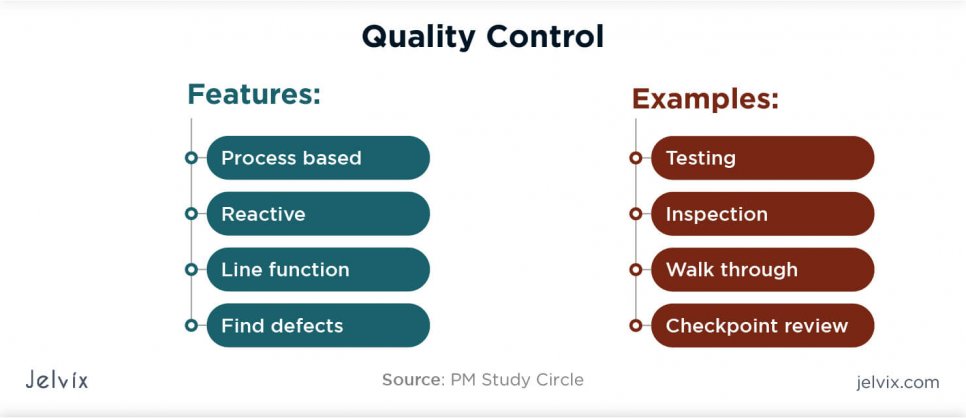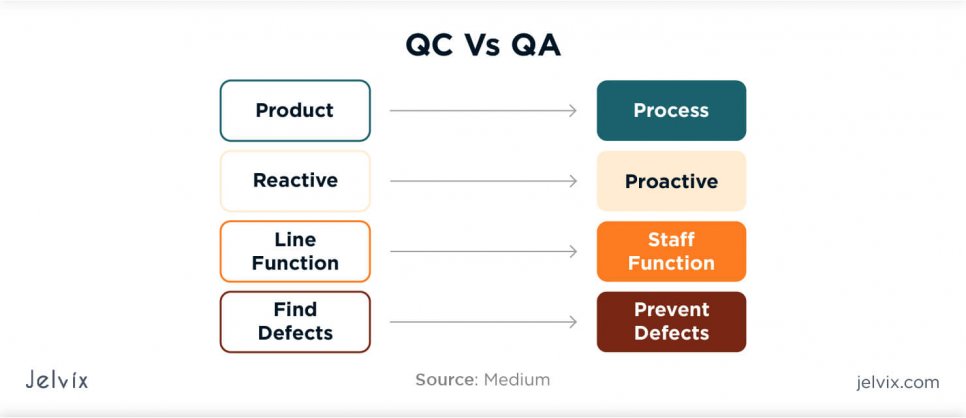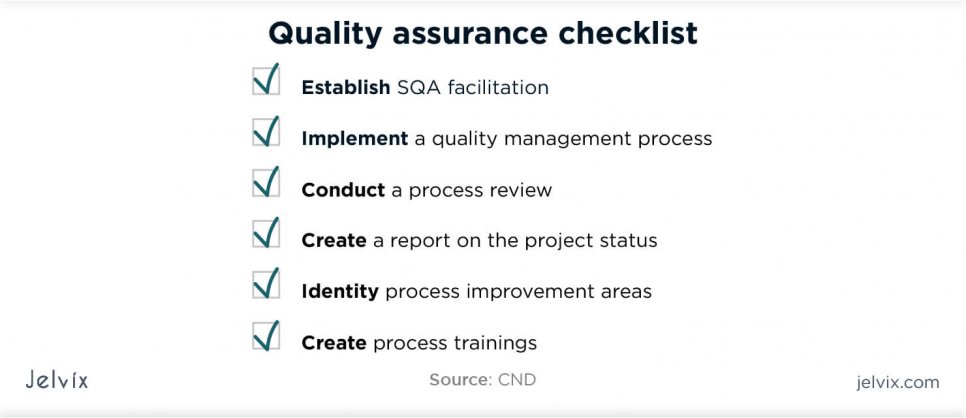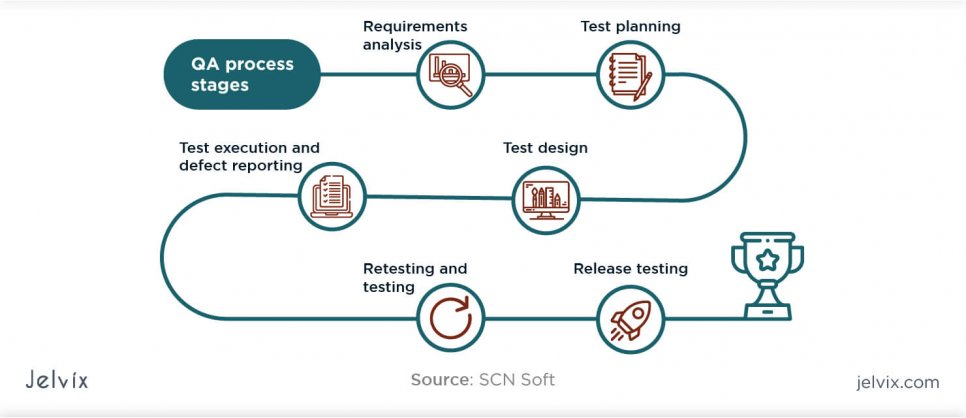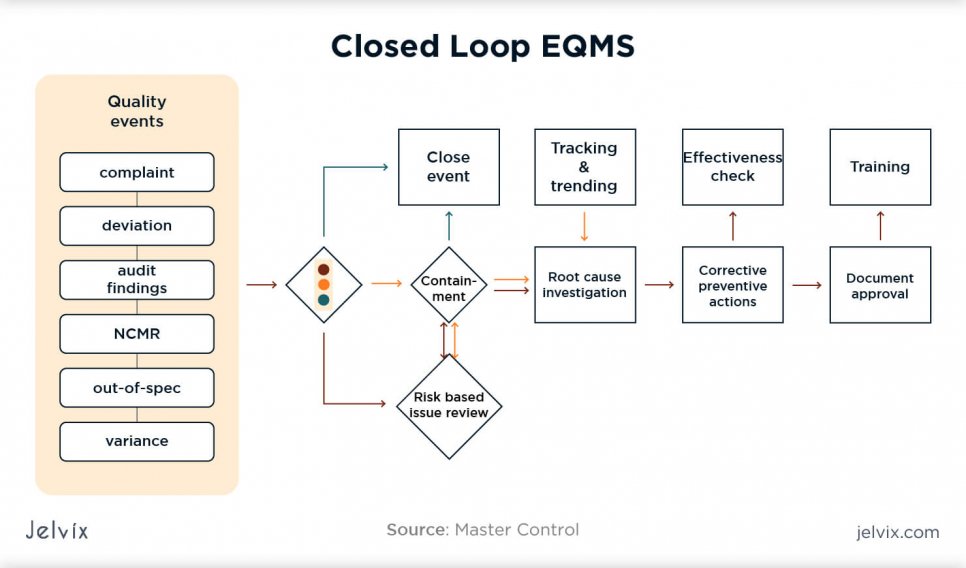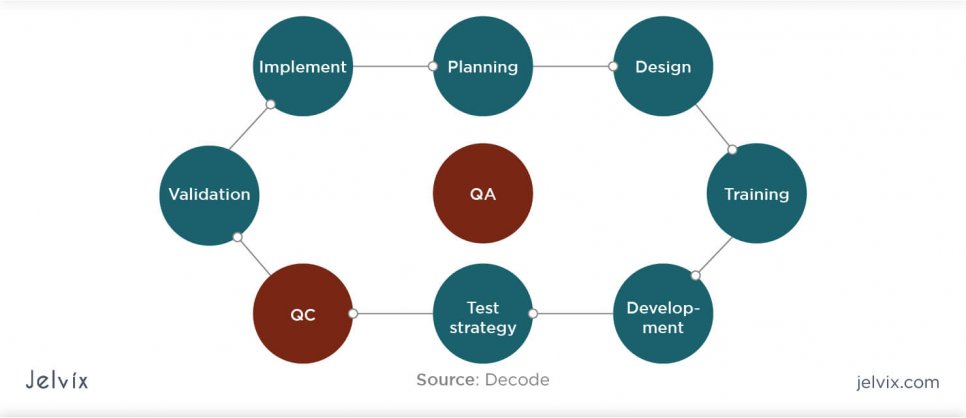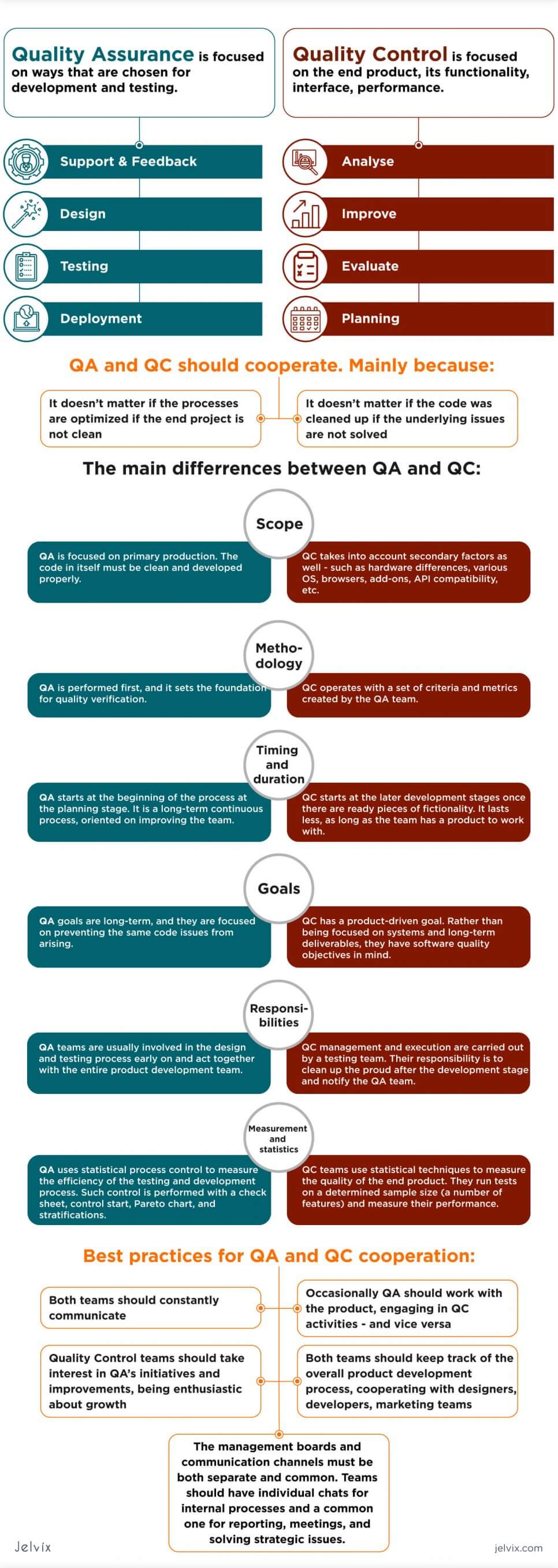Lately, we’ve seen a lot of debate regarding distinguishing quality assurance (QA) and quality control (QC). The common distinction is that QA is process-oriented, whereas QC is product-oriented.
This premise is undeniably true, but once a team starts implementing both, it becomes clear that a single distinction between quality assurance vs quality control doesn’t provide enough applicable information.
When testers start implementing QA, they inevitably face several issues. Are QA/QC fully separate processes? How do you assign responsible members? What goals to define for each process? Most importantly, what are the risks of carrying out QA vs QC entirely independently?
We share our view on the differences between quality assurance vs quality improvement, common approaches, risks, and similarities.
The key distinction between quality control vs quality assurance
Quality Assurance is focused on the ways that are chosen for development and testing, checking if the team is doing things with the right method.
Quality Control is focused on the end product, its functionality, interface, and performance.
Quality Control analyzes the product and provides the QA team with feedback. The goal of the QA team is to find the underlying problem of why the code issues appear.
Distinguishing between QC and QA helps teams not only to be focused on the well-functioning product but also to maintain best practices within the team. If a QA team does a good job analyzing and fixing processes, the QC team will have fewer issues to deal with in the long-term perspective.
What is quality assurance?
Quality Assurance ensures the absence of deep-rooted issues in the development and testing processes. Testers analyze the defects in the approach to coding and fix them on a long-term basis, relaying feedback to the development team. The goal is not only to remove an issue but also to avoid the same error again.
Quality Assurance is proactive – it aims at preventing issues before they are detected in the product. The team performs audits, keeps track of documentation, communicates with the development team, introduces automation, and code quality tools. The QA team is responsible for refining product requirements and building strategies to fill them out.
So, QA’s priority is to increase the team’s productivity, prevent issues, and optimize the processes. This is done via documentation, planning, audit, and training.
What’s product quality control?
QC is a set of activities that are performed to improve the final product. The goal is to deliver clean code, fast performance, and intuitive user experience. For QC, results matter more than processes. Without QA, QC would only be oriented towards short-term fixes. The quality of work would not improve, and QC team would have to deal with the same bugs on and on.
Without QC, QA would not know what areas that must be improved. The direction the Quality Assurance works in is largely based on the feedback from QC specialists.
Quality Control is a reactive approach, focused on finding already existing defects rather than preventing them. This is done through product testing, checkpoint review, codebase analysis, and practical use cases.
Main differences between quality assurance vs quality control
Before we move on to subtle methodological differences, let’s recap two key distinctions of quality assurance versus quality control.
Progress vs product
- QA is oriented towards improving long-term processes while QC is focused on delivering the best product;
- Fixes done by the QC team are usually short-term but well-visible, whereas the QA team delivers results over time, but they improve the process long-term;
- QC team detects issues with the product and sends them to QA. QA analyzes these errors and determines which internal processes could have become the cause;
- QC is focused on fixing. QA – on optimization.
Proactive vs reactive
- QA team performs audits, code analysis, and teaching sessions to establish best testing and development practices early on in order to prevent actual product issues;
- QA teams are focused on dealing with issues at hand, reacting to problems rather than identifying possible areas;
- QA is focused on establishing long-term methodologies, whereas QC’s main priority is to fix a particular code issue quickly.
- Without QA, the team cannot establish the best testing practices; without QC, they cannot deliver the product according to requirements.
Quality assurance versus quality control: additional differences
Both components of Quality management are equally important. However, when it comes to practical implementation, teams have concerns regarding the cooperation between QA and QC. To which extent are the two fields independent? Can one influence the other, and where do the competences of which end and begin? Surely, neither QA nor QC teams would like their workflows to be interrupted, but is full isolation a solution?
QA and QC should cooperate, mainly because:
- It doesn’t matter if the processes are optimized if the end project is not clean;
- It doesn’t matter if the code has been cleaned up if the underlying issues are not solved.
Let’s examine the differences between the two fields to see where the competences of both fields lie.
Scope: quality assurance and quality control
Quality assurance is focused on primary production. The code itself must be clean and developed properly. QC takes into account secondary factors as well – such as hardware differences, various OS, browsers, add-ons, API compatibility, etc.
If we transformed software development into food production, Quality Assurance would be responsible for ensuring that the food is cooked properly. Quality Control would detect if it hasn’t been contaminated by bacteria, chemicals, or gone bad.
Another field that has a scope similar to QA is Quality Improvement. Just like assurance, improvement considers the bigger picture, but at the same time, it also takes action to remove issues. Quality assurance versus quality improvement are different in their methodologies: QA is theoretical, while improvement is action-driven. In a way, it’s a mix of QA and QC. If assurance and control teams collaborate, they work similarly to improvement teams.
Methodology
QA is performed first, and it sets the foundation for quality verification. QA developers step in the project with a particular Quality Assurance methodology:
- Analyzing the development process and its efficiency via an audit;
- Defining product requirements, metrics, and benchmarks for the product;
- Setting up the list of criteria that a product must respect;
- Defining user expectations, talking to stakeholders, evaluating competitors, and taking insights from them;
- Educating the team on the best testing and development processes.
Learn more about functional vs non-functional requirements to set clear benchmarks for the product.
Quality Control operates with a set of criteria and metrics created by the QA team. The control team is focused on executing the product and pinpointing even the slightest issues. Comparing QA/QC procedures, QC bases its activities on QA’s requirements.
- Executing the program in order to assess its performance and overall code quality;
- Verifying the requirements provided by the QA specialists;
- Using metrics, defined by QA or adding their own;
- Communicating the feedback back to the QA team so that they can incorporate those insights into their long-term practices, optimization, and automation.
Quality Assurance activities are visionary – teams need to think long-term, create strategies, and plan in advance. Quality Control is a more hands-on-deck field that deals with tangible problems in hand.
Timing and duration
Quality Assurance starts at the beginning of the process at the planning stage. When teams create software requirement specification documents and software development plans, the QA team already participates. They are defining product requirements, devising metrics, and defining the best standards.
Quality Control starts at the later development stages once there are ready pieces of functionality. Quality control is the most active when the development is finalized, and the team has access to the full product – in the pre-deployment stage.
QA is a long-term continuous process, oriented at improving the team. QC lasts less – as long as the team has a product to work on. Obviously, it’s quite a subtle difference between quality control and quality assurance, which can change according to the project.
Goals
QA goals are long-term, and they are focused on preventing the same code issues from arising. Take a look at some examples.
- Predictability: QA teams aim to minimize the number of unexpected technical issues, building established testing and development systems. Developers should know what time and results they can expect from a particular process.
- Efficiency: QA teams are focused on improving the development and testing speed, automating processes, keeping documentation, and reusable test cases. It can be measured via Points per Sprint or % of functionality covered in a sprint.
- User-driven: Quality assurance wants to deliver customer-centric products that derive directly from user needs. They handle communication with focus groups, potential uses, product owners, stakeholders. QA experts analyze feedback and create improvement strategies.
- Flexibility. The goal of a QA team is to build a set of practices that can fit the needs of any project.
Quality Control has a product-driven goal. Rather than being focused on systems and long-term deliverables, they have software quality objectives in mind.
- Reaching deliverables in every type of testing;
- Making sure that the product works on different devices, OS, in various browsers;
- Examining all most common use cases and seeing the product with the eyes of a user;
- Checking if the result complies with the requirements, devised by QA;
- Documenting all the processes, so QA experts can understand what code issues should be resolved long-term;
- Validating user experience and testing software’s functionality.
Responsibilities
QA teams are usually involved in the design and testing process early on and act together with the entire product development team. QA experts need to communicate with the developers, understand the specifics of all product development process stages.
This means being engaged in standups and team meetings early on, constantly communicating with stakeholders, reviewing competitors, etc.
As visionaries, QA needs to have all the information about the company, its needs, market, product requirements, tech stack, and be well aware of the specifics of the development process.
Quality control management and execution are carried out by a testing team. Their responsibility is to clean up after the development stage and notify the QA team.
They can join the project early on (like in DevOps), or once most of the codebase is ready. The timing depends on the project’s software development methodology.
Measurement and statistics
Both QA and QC rely on tangible statistical methods to measure their work objectively.
- Quality assurance uses statistical process control to measure the efficiency of the testing and development process. Such control is performed with a check sheet, control start, Pareto chart, and stratifications – diagrams that focus on defining multiple aspects of the system and bringing them into a united picture.
- Quality control teams use statistical Quality Control techniques to measure the quality of the end product. They run tests on a determined sample size (a number of features) and measure the performance. In software testing, it’s done with common software testing methods (performance testing, user testing, UI tests, etc).
Both QA and QC strive to make their workflow as measurable as possible. Having clear deliverables makes communication with other teams easier, allows predicting budget expenses, and measuring the team’s efficiency.
Outsourcing and consulting
In software development, it’s common to bring QA and QC experts from an expert outsourcing team. In-house teams don’t always have enough workload for QA and QC specialists that would justify the costs of hiring, onboarding, workspace, etc. Remote audits, consultations, optimization, and cooperation allows cutting organizational costs, getting an expert specialist with years of experience, and receiving a third opinion on the project.
The major advantage of hiring outsourcing QA and QC teams is their versatile approaches to methodologies. They have already devised best practices and can’t be biased by the company’s current workflow.
- Engaging a third-party QA expert is usually done to create a viable QA framework that a team will follow after the cooperation with the outsourcing team has ended. The goal is to create a long-term system, using expert knowledge, and bring the best practices to the team.
- Outsourcing quality control is usually done by engaging an outsourcing testing team. The goal of testers is to examine the product, detect and fix issues, and deliver a functional product. They can bring in their own QA experts for defining product requirements or cooperate with in-house QA experts.
Cooperation between quality assurance and control teams
Although QA and QC are independent units, fully splitting these two processes may lead to three key risks.
No feedback
A QA specialist will not be able to implement an innovative process without having experience of working with a product. Seeing how adopted methodologies directly impact the software, its performance, and functionality – is a key factor in becoming a QA expert. QA experts should see the tangible results of their work – and clean code is a direct outcome.
Avoiding basic clean-up
Many quality managers prefer quality assurance over quality control because this work is more creative. “Dirty” tasks like refactoring, cleaning up tech debt, fishing out bugs often fall off the priority list. This is why all QA team members should occasionally be involved in QC work or at least cooperate directly.
No bigger picture
We already know the risks that can arise when QA specialists are too detached from the product quality. However, when QC teams only focus on short-term goals without paying attention to processes, they also risk stagnation. It’s important that automation, optimization, performed by QA teams, reaches QC teams, too, improving their workflow.
Miscommunication
If QA and QC teams don’t agree on approaches to improve code and processes, the entire team might lose trust. It will poorly impact product quality and teams’ efficiency. Both teams should know how the other one is working and possibly occasionally switch roles – just to understand the issues on the other side.
Navigate the product development lifecycle with expert tips for faster, smarter results.
Building smooth cooperation between QA and QC
QA and QC cooperate in a cycle. The starting point is the QC team – they form product requirements, set criteria, and provide a set of metrics. QC takes over by implementing these frameworks into actual testing. Then QC sends their insights back to QA – now, the assurance team can use the feedback to detect development and testing issues.
Once QA is done with the first interaction of optimization, they communicate the insights to QC. QC comes back to the product, and the cycle continues. This cyclic system is the right approach for combining quality assurance and control – both teams should communicate and exchange insights all the time.
Best practices for QA and QC cooperation
- Both teams should constantly communicate;
- Occasionally QA should work with the product, engaging in QC activities – and vice versa;
- Quality Control teams should take an interest in QA’s initiatives and improvements, being enthusiastic about growth;
- Both teams should keep track of the overall product development process, cooperating with designers, developers, and marketing teams;
- The management boards and communication channels must be both separate and shared. Teams should have individual chats for internal processes and a shared one for reporting, meetings, and solving strategic issues.
Conclusion
Quality Assurance and Quality Control are both indispensable processes in Quality Management. Drawing the distinctions between the two helps to define clearly their scope and priorities. Having separate QA and QC experts brings clarity to the process and allows teams to focus both on short-term and long-term objectives.
However, QA and QC shouldn’t exist entirely separately. The two teams should constantly communicate, exchange experience and insights, participate in shared meetings, and talk to stakeholders. It’s important that the teams are on the same page instead of competing with one another.
Our QA and QC teams work on the same management boards, participate together in meetings, and are always kept in the loop. They regularly communicate with developers, designers, and marketing managers – every member not only sees the bigger picture but also pays attention to details.
So far, this approach works well for us. We are open to sharing our experience and methodologies – feel free to reach out to our QA and QC experts for details.
Looking for a reliable QA & testing team?
Get in touch to receive a consultation on your product testing strategy.


